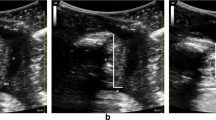Abstract
The aims of the present study were to evaluate test–retest intra-observer repeatability of ultrasound measurement of the morphology and function of the pelvic floor muscles (PFMs). Seventeen subjects were tested twice. Two-, three- and four- dimensional ultrasound recorded cough, huff, muscle morphology and PFM contraction, respectively. Analyses were conducted offline. Measurements of levator hiatal dimensions demonstrated intra-class correlation coefficient (ICC) values of 0.61, 0.72, 0.86 and 0.92, for the anterior-posterior dimension, transverse dimension, resting area and narrowing during contraction, respectively. Muscle thickness showed variable reliability. ICC values for measurement of the position of the bladder neck were 0.86 and 0.82 at rest, in the vertical and horizontal direction. Displacement of the bladder neck during contraction, huff and cough demonstrated ICC values of 0.56, 0.59 and 0.51, respectively. Perineal ultrasound is a reliable method for measuring most of the tested parameters of morphology and function of the PFMs.




Similar content being viewed by others
References
Kegel AH (1956) Stress incontinence of urine in women; physiologic treatment. J Int Coll Surg 25:487–499
Bo K (2004) Pelvic floor muscle training is effective in treatment of female stress urinary incontinence, but how does it work? Int Urogynecol J Pelvic Floor Dysfunct 15:76–84
Strohbehn K, Ellis JH, Strohbehn JA, DeLancey JO (1996) Magnetic resonance imaging of the levator ani with anatomic correlation. Obstet Gynecol 87:277–285
Chou Q, DeLancey JO (2001) A structured system to evaluate urethral support anatomy in magnetic resonance images. Am J Obstet Gynecol 185:44–50
Kearney R, Miller JM, DeLancey JO (2006) Interrater reliability and physical examination of the pubovisceral portion of the levator ani muscle, validity comparisons using MR imaging. Neurourol Urodyn 25:50–54
DeLancey JO, Kearney R, Chou Q, Speights S, Binno S (2003) The appearance of levator ani muscle abnormalities in magnetic resonance images after vaginal delivery. Obstet Gynecol 101:46–53
Hoyte L, Schierlitz L, Zou K, Flesh G, Fielding JR (2001) Two- and 3-dimensional MRI comparison of levator ani structure, volume, and integrity in women with stress incontinence and prolapse. Am J Obstet Gynecol 185:11–19
Tunn R, Paris S, Fischer W, Hamm B, Kuchinke J (1998) Static magnetic resonance imaging of the pelvic floor muscle morphology in women with stress urinary incontinence and pelvic prolapse. Neurourol Urodyn 17:579–589
Dietz HP, Shek C, Clarke B (2005) Biometry of the pubovisceral muscle and levator hiatus by three-dimensional pelvic floor ultrasound. Ultrasound Obstet Gynecol 25:580–585
Bernstein IT (1997) The pelvic floor muscles: muscle thickness in healthy and urinary-incontinent women measured by perineal ultrasonography with reference to the effect of pelvic floor training. Estrogen receptor studies; biometry. Neurourol Urodyn 16:237–735
Schaer GN, Koechli OR, Schuessler B, Haller U (1995) Perineal ultrasound for evaluating the bladder neck in urinary stress incontinence. Obstet Gynecol 85:220–224
Peschers U, Schaer G, Anthuber C, DeLancey JO, Schuessler B (1996) Changes in vesical neck mobility following vaginal delivery. Obstet Gynecol 88:1001–1006
Dietz HP, Wilson PD, Clarke B (2001) The use of perineal ultrasound to quantify levator activity and teach pelvic floor muscle exercises. Int Urogynecol J Pelvic Floor Dysfunct 12:166–168
Dietz HP, Wilson PD (1998) Anatomical assessment of the bladder outlet and proximal urethra using ultrasound and videocystourethrography. Int Urogynecol J Pelvic Floor Dysfunct 9:365–369
Messelink B, Benson T, Berghmans B, Bo K, Corcos J, Fowler C et al (2005) Standardization of terminology of pelvic floor muscle function and dysfunction: report from the pelvic floor clinical assessment group of the International Continence Society. Neurourol Urodyn 24:374–380
Tubaro A, Artibiani W, Bartram C, DeLancey JD, Dietz HP, Khullar V et al (2005) Imaging and other investigations. In: Abrams P, Cardozo L, Khoury S, Wein A (eds) Incontinence, 2005 edition. Health Publication, Plymouth, UK, pp 707–797
Peschers UM, Fanger G, Schaer GN, Vodusek DB, DeLancey JO, Schuessler B (2001) Bladder neck mobility in continent nulliparous women. BJOG 108:320–324
Reddy AP, DeLancey JO, Zwica LM, shton-Miller JA (2001) On-screen vector-based ultrasound assessment of vesical neck movement. Am J Obstet Gynecol 185(1):65–70
Thompson JA, O’Sullivan PB, Briffa K, Neumann P, Court S (2005) Assessment of pelvic floor movement using transabdominal and transperineal ultrasound. Int Urogynecol J Pelvic Floor Dysfunct 16(4):285–292
Armstrong SM, Miller JM, Benson K, Jain S, Panagopoulos K, DeLancey JO et al (2006) Revisiting reliability of quantified perineal ultrasound: Bland and Altman analysis of a new protocol for the rectangular coordinate method. Neurourol Urodyn 25:731–738
Yang JM, Yang SH, Huang WC (2006) Biometry of the pubovisceral muscle and levator hiatus in nulliparous Chinese women. Ultrasound Obstet Gynecol 28:710–716
Dietz HP, Haylen BT, Broome J (2001) Ultrasound in the quantification of female pelvic organ prolapse. Ultrasound Obstet Gynecol 18:511–514
Altman DG (1999) Practical statistics for medical research. Chapman & Hall, London
Thomas JR, Nelson JK, Silverman SJ (2005) Reaseach methods in physical activity, 5th edn. Human Kinetics, Champaign
Majida M, Brækken IH, Bo K, Umek W, Dietz HP, Ellstøm Engh M (2006) 3D and 4D ultrasound of the pelvic floor. An interobserver reliability study. Int Urogynecol J Pelvic Floor Dysfunct 17(Suppl 2):136–137 (Abstract)
Bo K, Kvarstein B, Jorgensen J, Larsen S (1990) Pelvic floor muscle exercise for the treatment of female stress urinary incontinence. III. Effect of two different degrees of pelvic floor muscle exercises. Neurourol Urodyn 9:489–502
Bo K, Talseth T, Holme I (1999) Single blind, randomised controlled trial of pelvic floor exercises, electrical stimulation, vaginal cones, and no treatment in management of genuine stress incontinence in women. BMJ 318(7182):487–493
Morkved S, Bo K, Fjortoft T (2002) Effect of adding biofeedback to pelvic floor muscle training to treat urodynamic stress incontinence. Obstet Gynecol 100:730–739
Balmforth JR, Mantle J, Bidmead J, Cardozo L (2006) A prospective observational trial of pelvic floor muscle training for female stress urinary incontinence. BJU Int 98:811–817
Guaderrama NM, Liu J, Nager CW, Pretorius DH, Sheean G, Kassab G et al (2005) Evidence for the innervation of pelvic floor muscles by the pudendal nerve. Obstet Gynecol 106:774–781
Kegel A (1952) Stress incontinence and genital relaxation. Ciba Clin Sympos 2:35–51
DeLancey JO (1994) The anatomy of the pelvic floor. Curr Opin Obstet Gynecol 6:313–316
Acknowledgements
We gratefully acknowledge support for this research through the EXTRA funds from the Norwegian Foundation for Health and Rehabilitation and the Norwegian Women’s Public Health Association.
Author information
Authors and Affiliations
Corresponding author
Rights and permissions
About this article
Cite this article
Brækken, I.H., Majida, M., Ellstrøm-Engh, M. et al. Test–retest and intra-observer repeatability of two-, three- and four-dimensional perineal ultrasound of pelvic floor muscle anatomy and function. Int Urogynecol J 19, 227–235 (2008). https://doi.org/10.1007/s00192-007-0408-7
Received:
Accepted:
Published:
Issue Date:
DOI: https://doi.org/10.1007/s00192-007-0408-7




